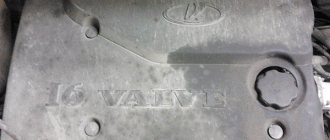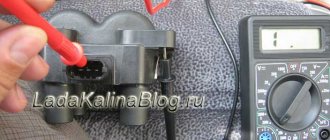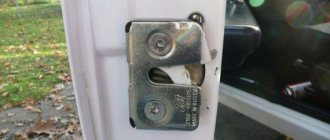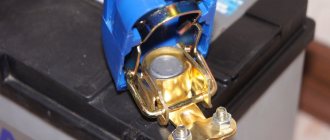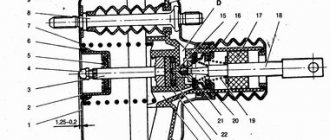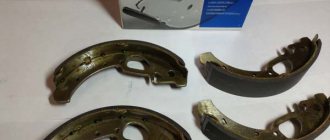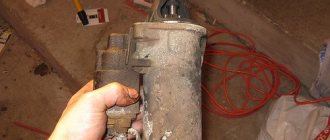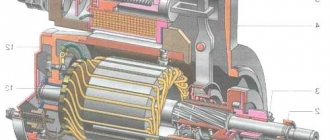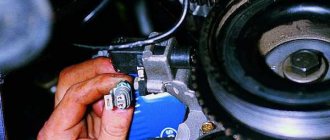The starter does not turn on a Priora
A car has long ceased to be a luxury. It’s hard to imagine life without a car these days. Many people drive a car every day and for any need - to work, study, dacha, shopping, on vacation. And that's why it becomes very bad when the car won't start. Plans are ruined, meetings are cancelled, people lose money!
We will look at situations where the starter works, but the car still does not start, another time. And now - about what to do if the starter on a Priora does not turn.
First, let's understand how a starter works and what its structure is. An electric motor with a gear that meshes with the engine flywheel and turns it when started. All this is hidden in a housing on which the solenoid relay is mounted. It is designed to control the movement of the gear and supply power to the electric motor.
When you turn the ignition key, current is supplied to the relay. Using an electromagnet, it is retracted, using a special mechanism, it moves the gear and starts the engine by closing the contacts. When the key is released, power stops being supplied to the magnet of the solenoid relay, the relay operates in the other direction and the contacts open. So, we know what the principle of operation of the starter looks like in general terms, so now it will be easier for us to understand why the starter does not turn on the Priora.
If you hear clicking sounds when you turn the ignition key and the lights on the instrument panel go out, it may be the battery. It needs to be checked, recharged, topped up with electrolyte or replaced. Is the battery OK? Then the situation becomes more interesting. Check the wires that come from the battery. If they get hot, check their contact with the battery. Remove the terminals from the battery, clean, lubricate them (sometimes oxidation occurs) and reinstall.
Check the connection between the ground terminal and the body. If necessary, clean this connection. Check the connection between the plus terminal and the starter. Determine if power is supplied to the solenoid relay from the ignition switch. To do this, you need to disconnect the connector from the relay, and turn the ignition key “to start” and measure the voltage at the connector.
The Priora starter still won't turn? Then you will have to remove it from the car and check it.
The removal procedure looks like this: disconnect the battery terminals, unscrew and remove the air filter, unscrew and remove the positive wire from the starter. Then disconnect the connector from the relay, unscrew the starter mounting nuts and remove it. We are already much closer to solving the question of why the Priora’s starter does not turn. Now we take the wires for lighting (crocodiles) and connect them with the negative wire of the battery and the starter housing. We connect the positive one to the relay connector, after which the gear should be activated and ejected forward. If not, change the retractor.
You can hook the negative wire to the starter housing, and the positive wire to the lower terminal of the solenoid relay. The electric motor didn't work? The culprit is most likely the motor brushes.
Basic faults
Externally, a breakdown of the Priora starter can be recognized by the following signs:
- “turns” and at the same time starts the engine;
- does not “twist”;
- continues to “twist” after the key is released;
- creaks, clicks are heard;
- It spins, but for too long.
The reason may lie in a faulty battery, in the starter itself and fuses. The most common are those that are most likely to disable
the car – it’s worth taking a closer look.
Doesn't turn on
If the engine does not start, the problem may be:
- discharged or broken battery;
- no closure of contacts 50 and 30;
- terminals or tips are oxidized;
- interturn closure;
- short circuit to ground;
- open circuit “starter - traction relay”;
- the ignition module is faulty;
- break in the traction relay winding;
- brush wear;
- the anchor jams;
- the additional relay or the control circuit connected to it is damaged.
Clicks won't start
If the starter clicks but does not turn, there may be several reasons:
- the gear working with the bendix does not engage with the engine flywheel;
- the bearing of the armature shaft bushings is worn out;
- the starter mount or housing is broken;
- gear or flywheel teeth are damaged.
Doesn't turn off
When the Priora starter unit does not turn on, the problem may lie in the following:
- the freewheel slips;
- the battery is discharged or broken;
- sudden and severe voltage drop in the circuit;
- oxidation of contacts.
Starter rotates slowly
Reasons for slow performance may include:
- the battery is discharged or broken;
- terminals or tips are oxidized;
- the connection of wires from the power unit to the body is very weak;
- the contact bolts on the traction relay are loose or oxidized;
- brush wear;
- a short circuit or break has occurred in the armature winding.
If the Priora does not start well when hot
In this case, see the second table; in addition to the reasons described, also pay attention to:
- A pressure regulator that can discharge fuel through a membrane into the receiver.
- DPKV contacts, if the sensor has been changed, check that the poles are connected correctly.
- Faulty ignition module.
Let us remind you that in some cases the Priora does not start due to a faulty immobilizer or alarm system. In some cases, reflashing the engine ECU (electronic control unit) helps solve the problem of poor starting. And regular car maintenance will help eliminate problems of poor engine starting.
Possible causes of problems with starting the Lada Priora engine
The car has long become an integral part of our lives.
It is quite difficult for many of us to imagine life without him. But sometimes there comes a time when the car stops starting at the most inopportune time. Faced with such a problem, many car owners have no idea what to do in such a situation. We will try to help solve the problem when the Priora does not start and the starter does not turn the engine and what actions should be taken first.
How does a starter work?
This device is an electric motor with a gear that meshes with the engine flywheel and rotates it when started. A retractor relay is installed on the housing, which controls the movement of the gear and the automatic activation of the electric motor.
When the ignition key is turned to the start position, power is supplied to the relay and, through an electromagnet, it is drawn in, moving the gear using a special mechanism and simultaneously closing the contacts, starting the electric motor.
The moment the ignition key is released, power stops flowing to the relay magnet; it operates in the opposite direction, opening the contacts. Thus stopping the operation of the electric starter. Here is an approximate elementary diagram of the operation of the engine starting system.
Repair and replacement of the engine start switch
Lada Priora hatchback Logbook Steering rack repair
The ignition switch of the Lada Priora is an electromechanical device consisting of a contact group and electrical communications. This engine starting system component wears out when the tracks are switched on and off repeatedly. When they are mechanically damaged, current conductivity deteriorates, resistance and temperature in the contact area increase, which leads to their burning. Another reason for ignition switch failure is the breakdown of plastic parts.
Malfunctions associated with problems with electrical connectors arise due to overload of the contact group caused by the connection of additional high-power devices. Another problem is short circuit. On the latest car models, modified designs are installed that have a more reliable contact group. If these defects are detected, the Priora ignition switch with immobilizer assembly will need to be replaced.
First you need to disconnect the negative battery terminal, then remove the plastic steering column cover, the electrical connector of the main wiring harness and the instrument mode switch. The next step is the most difficult: you need to remove the screws securing the lock to the steering column. They have round tear-off caps that provide an additional degree of security for access to the ignition switch. For this reason, they should be unscrewed carefully, using a special sharp chisel, lightly tapping it with a hammer. It is enough to make one turn of the screw to be able to unscrew it by hand. By unscrewing all four fasteners, you can remove the lock fixing bracket. The final stage is to disconnect the plug of the contact group. After replacement, installation of the removed parts is carried out in the reverse order.
Where to start if the starter does not turn and the Priora does not start after several attempts
If the relay makes a clicking sound when you turn the key:
- at the same time, the lights on the dashboard go out;
- it is necessary to check the battery charge;
If the battery is ok:
- after several attempts to start the car, touch the wires coming from the battery; when they heat up, you need to check the contact between them and the battery;
- remove the terminals from the battery and clean them;
- reinstall the terminals;
- check the connection of the ground terminal to the body, if necessary, clean the connection;
- check the connection of the positive terminal with the contact on the starter;
- it is necessary to check whether power is supplied to the relay from the ignition switch; to do this, disconnect the connector from the solenoid relay;
- turning the ignition key to the “start” position, use a tester to measure the voltage at the connector;
If all of the above does not have an effect, you need to remove the starter from the car and check it.
Battery
As we know, when you turn the key, the starter
, which begins
to rotate
the crankshaft. If this unit does not respond to the described action, they immediately climb to the battery. It is well known that if the voltage drops to 10 volts or below, the starter, by and large, will not be able to work. But it is worth realizing that low performance does not necessarily indicate battery dilemmas. Quite often, unsuccessful attempts to start the engine lead to this. To avoid battery drain, you should not repeat them more than 2-3 times. The problem also appears due to improper operation of the generator.
As a result, the battery will need to be fully charged. Only then can you try to start again. In order not to waste time, it is best to replace the battery with a previously serviceable one.
You can ask permission from someone you know to connect to their battery directly. If the problem is solely in the battery, then the engine will start without much difficulty.
Removing the starter
- disconnect the terminals from the battery;
- unscrew the air filter and remove it;
- Unscrew and remove the positive wire from the starter terminal;
- disconnect the connector from the relay;
- unscrew the starter mounting nuts and remove it;
Checking the relay operation
Using emergency wires for “lighting up”, connect the negative wire from the battery to the electric starter housing. Connect the positive one to the relay connector, and it should operate and throw the gear forward. If the result is negative, the relay must be changed.
Checking the operation of the electric motor
By hooking the negative wire to the electric starter housing, and the positive wire to the lower terminal of the retractor relay. The electric motor should start working. If this does not happen, then most likely the motor brushes need to be replaced.
Having examined the reasons why the starter does not turn and the Priora car does not start, we can conclude that the electric starter itself may not always be the cause of the problem. Most often these are bad contacts in the system connections or simply a broken wire.
But if the reason is still in the starter, do not rush to buy a new one. Many faulty parts can be replaced by simple overhaul, saving money. And the old starter will last for a long time.
Option - warm seats for additional car comfort
Every owner strives to make his car more comfortable. In winter conditions, the option of heated seats will be very appropriate. It's always nice to sit in a warm chair. You quickly get used to this option. If the car does not yet have heating installed, it can be installed
Malfunctions of the Lada Kalina car
Every car owner usually has to deal with a situation in which his car does not start. This is quite a serious problem, especially when the malfunction occurs in winter. In such cases, you need to contact qualified specialists, you can also try
Carburetor DAAZ-4178 - installation and main causes of malfunctions
The Dimitrovgrad Automotive Component Plant produces DAAZ-4178 carburetors for UAZ vehicles, which can be used instead of the standard K-151V. The manufacturer guarantees an increase in dynamics and a reduction in fuel consumption to the level of 11 liters per 100 km in mixed mode, which is comparable to the fuel consumption of a GAZ
Causes of motor breakdowns and methods for eliminating them
Every driver faces such a problem when his car breaks down and won’t start. The reason for this is often a malfunction of the starter. It is a specific electric motor that uses a battery to receive power. Main faults and their
Determining the causes of a windshield wiper malfunction on a VAZ car
wipers If suddenly the wipers on your car stop working, this is not a reason to panic. This device is quite simple and, if desired, anyone can independently eliminate the cause of the malfunction by following the further instructions. And so, let's find out why the wipers on your VAZ-2105 do not work.
How to detect and fix problems in the windshield wiper system of a Lada Kalina car
The design of the windshield wiper system is a fairly simple diagram. If desired, any car owner is able to understand the cause of the malfunction and fix it independently.
Tips for motorists
The starter, which is installed on the Lada Priora passenger car, has catalog number 2111.3708010-01. Its electrical connection diagram is similar to other brands of VAZ cars, but changes have been made to the design of the starter itself regarding the transmission of torque from the armature shaft. This starter is equipped with a planetary mechanism, which is driven by the armature shaft, and the planetary gear carriers rotate the shaft on which the overrunning clutch and the starter drive gear are located. Changes to the design have been made to make the “life” of the starter motor easier by increasing the torque with a planetary gearbox.
Malfunctions that lead to starter failure are divided into two groups: electrical and mechanical . The search for the cause of the failure usually begins with the electrical part if the starter armature does not show signs of life. First of all, check the 15 amp fuse F1 . It is blue in color and is located on the right side of the floor tunnel in the area where the front passenger's feet are located. If it is intact, then you will have to check the functionality of the starter relay K3 , which is located in the mounting block. The culprit may also be a bad contact in the block at the main relay, which is why the starter relay will not work. And the ignition switch can also fail.
Next, you will have to check whether voltage is supplied to the contacts of the relay, which is called traction. If there is voltage, but the relay armature does not move (there is no click), then it will have to be replaced. If this relay is in working condition, but you cannot hear the rotation of the armature, then you will have to look at the battery terminals for oxidation, as well as the fastening of the wires going from the battery to the traction relay. If, when you try to turn on the starter, the armature does not rotate again, you will have to remove the traction relay and check whether its internal contacts are burnt. In addition, the reason for the armature not rotating could be its brushes, if they are worn out or stuck.
When the electrical part of the starter is working properly, its armature will rotate, but in order for the torque to be transmitted to the flywheel ring gear, the starter drive gear must be engaged with it. to find out the mechanical causes of a starter malfunction on a Lada Priora only after removing it from the engine and disassembling it. The most common malfunction is wear of the overrunning clutch, as a result of which the drive gear will not rotate, although it will engage with the flywheel ring gear.
Much less common are malfunctions associated with wear of the teeth of the starter drive gear and the flywheel ring gear. In this case, the grinding noise of the gears trying to engage will be clearly audible, but due to their wear this does not happen. There are also cases when the drive lever is disconnected from the traction relay armature, which prevents the starter drive gear from moving towards the flywheel.
What to do if the Lada Priora does not start and the starter does not turn
Now many Russians cannot imagine life without a car.
Therefore, it is easy to understand them when the vehicle suddenly stops starting at one, far from perfect moment. This is even more unpleasant if it happens in the morning before leaving for work. At the same time, many car enthusiasts are lost in such a situation and have absolutely no idea how to fix the breakdown on their own.
This material will tell you why a car like Priora may not start in cold weather, and why its starter does not turn. It is important to note that in most cases the problem can be easily fixed on the spot, and if you know how to do this, you can save a lot of money on a car service.
Causes and solutions
If the car does not start because the starter does not turn, but makes characteristic clicks, there may be several reasons for this:
- The power wire connecting the relay winding and the starter has burned out.
- The brushes and bushings are out of order.
- The armature is shorted on the winding.
- The winding has broken.
- The fork on the drive is deformed or destroyed.
The cause may also be insufficient battery charge. In some cases, to eliminate this problem, it is enough to charge the battery and try to start the car again. The cause may be jamming of the motor shaft and bushing. It is possible that the rotor caught the “plus” of the stator. It is also possible that the winding is shorting.
Even if the problem is easily and quickly solved, one glance will not be enough to detect it. To understand the reason, you first need to let the car cool down (this requirement is especially important in hot weather).
You will have to remove the clicking starter.
If the problem is with the shaft, it needs to be tightened. It may have malfunctioned. Then the shaft will need to be replaced, after which the starter will continue to function normally. If the bushings are deformed, they will need to be replaced. This happens extremely rarely, so in most cases you will not have to replace the bushing to fix the problem. If the rotor rubs against the stator, the shaft must be aligned. You can determine whether a wire has burned out by the appearance of black spots and a characteristic odor.
Reasons for failure of the starting system
Most often the following happens:
- For some reason the electric starter does not turn on - the reason is a broken wiring, short circuit or breakdown of the traction relay;
- the starter starts, but an uncharacteristic clicking sound is heard - damage to the coil of the above relay or discharge of the battery;
- the start works, but the starter does not turn or rotates too slowly - the battery is dead.
In addition, the reason here may lie in:
- loss of contact;
- brush wear;
- collector contamination;
- short circuit of the winding wires.
Troubleshooting Starter Problems
The starter is an important element of the engine starting system. Its task is to ensure vigorous rotation of the crankshaft, which transmits translational motion to the piston group, creating the necessary degree of compression in the combustion chamber and removing exhaust gases.
Basic starter malfunctions:
- short circuit in the traction relay winding;
- oxidation of wire tips;
- bendix jammed;
- break or short circuit in the starter winding;
- worn or damaged starter brushes.
First, you should conduct an external inspection of the Priora starter fuse: check the condition of the contacts, clean the oxidized terminals. It is necessary to evaluate the reliability of the ground connection with the engine and body. Then you need to try to start the car again. If the Lada Priora starter traction relay clicks, but it does not spin, the breakdown needs to be repaired.
If the device fails in the field, when it is not possible to contact a service station, you can jump start the car. For this you will need an assistant. Having accelerated the car with the ignition on, you need to quickly engage second gear and release the clutch: the car starts to twitch, but after two or three jerks it starts. This is the most popular method of starting the engine when the battery is dead or the starter is faulty, but it can only be used on vehicles with a manual transmission.
Repairing the Lada Priora starter can be done by removing it from the engine: this makes it easier to carry out preventive maintenance, unlock the bendex, and replace brushes. If a winding break occurs, you need to install a new starter assembly, and it is advisable to do this on a cold engine.
Starter operating principle
This device itself is a conventional electric motor. A gear is installed on it, which meshes with the flywheel, which rotates when the power unit starts. A traction relay is also attached to the housing. The functions of this element include:
- gear movement control;
- starter disconnection.
When the key is turned to the starting position, voltage is supplied to the relay, exciting the electromagnet windings, then the contacts close. At the same time, the gear begins to rotate and the motor starts.
When the key is released, the voltage to the relay windings stops supplying and the contacts separate. The starter is accordingly turned off. This is, in general, the entire description of the operation of the node in question.
Why may the starter not turn?
If the start occurs in a cold or frosty environment, then several attempts should be made before starting to troubleshoot. In case of a complete fiasco, when when you turn on the relay clicks and the indication on the panel goes out, you need to do the following:
- make sure the battery is charged;
- check whether all the wires coming from the battery are cold - the presence of heating indicates poor contact (the terminals need to be cleaned);
- see whether the battery connectors are securely connected to the ground, and whether it is securely connected to the body of the car (existent contaminants are eliminated);
- make sure that the plus on the starter contact is holding well.
The traction relay is disconnected from the wiring if there is doubt about the normal operation of the ignition switch. Then the key is set to start, and a multimeter is used to check the presence of voltage directly at the removed connector.
When none of the above helps, you will need to dismantle the starter itself.
How to remove the electric starter
The procedure in this case is as follows:
- remove the terminals from the battery;
- the “plus” connector is removed from the starter;
- removed from the relay block;
- The nuts securing the faulty unit are unscrewed.
Then you can safely remove it.
Next you will need to check the functionality of the relay. To do this, take emergency wires to start from another car. The negative one is installed on the battery and on the starter housing. “Plus” is connected to the relay. The latter in this case (if it works properly) is triggered and moves the gear. The absence of this reaction indicates a breakdown of this element.
When there is no reason to suspect the relay, you need to try to start the starter itself. The “minus” remains in place, and the “plus” is set to the lower output of the relay. The motor should start working. A negative result indicates wear of the graphite brushes.
